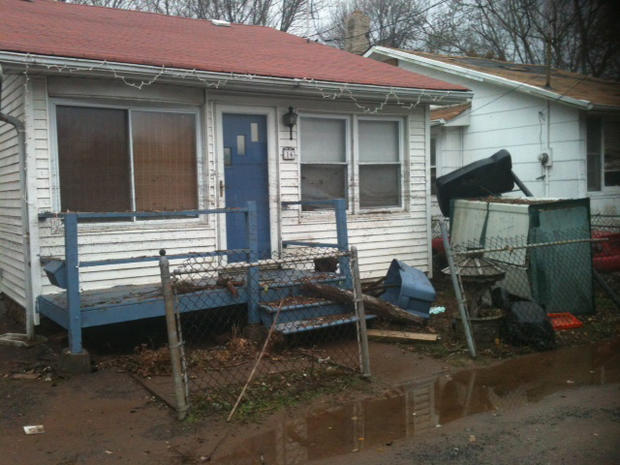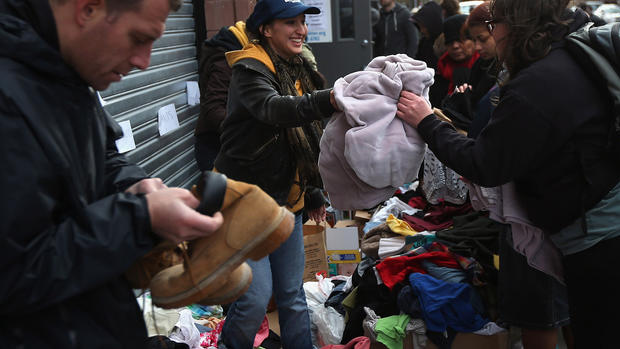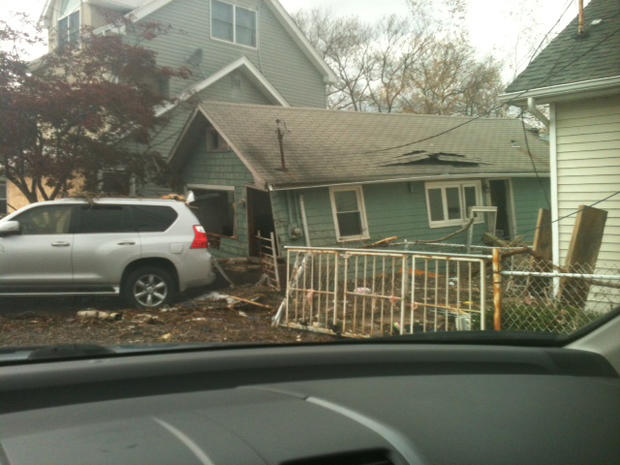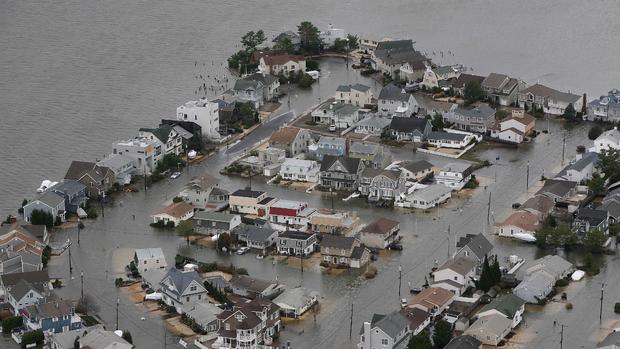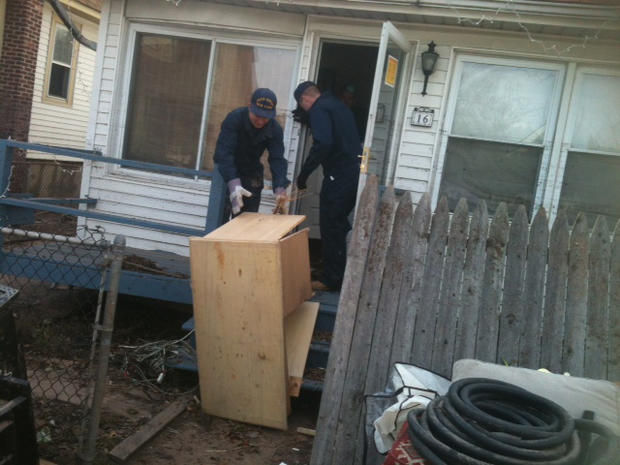Jazz musician rebuilds after losing Staten Island home to Sandy
An important part of jazz music is improvisation: the ability of the musicians to take the music into spontaneous and unexpected directions on the spot, and yet still be able to remain centered and grounded in the performance. Veteran bassist and teacher Santi Debriano has been playing jazz throughout his life, but he could have not anticipated having to improvise in a totally different performance--one that was more about survival than the music.
Last year, Santi and his then-fiancee (and now wife) Marilyn were uprooted from their home in Staten Island when Superstorm Sandy hit the borough. Compared to others who were left homeless by the storm, the couple -- through the help of friends and family -- were able to secure a new place in New Jersey within days after the event. Still, the transition didn't come without a price: a sense of shock, the loss of personal possessions in addition to their home; finding help and dealing with bureaucracy; and in Santi's case, being able to resume the normal flow of performing.
Almost a year later after Sandy, from the look inside their modest apartment in a suburban-like neighborhood in Jersey City, it would appear that the Debrianos had acclimated themselves fairly well to their relatively new digs. It was a far cry from the scene they had experienced in the days after the storm when their Staten Island home was filled with water, mud and debris.
Aside from what he said was the relentless ticketing by the Jersey City police over parking, Santi, 58, said he had no complaints about being in his current locale. "It's a quiet building," he told me this past summer on warm Saturday afternoon inside his living room. "Jersey City is nicely situated near Manhattan. In fact it's more convenient for me than Staten Island. You can get to Manhattan in a half-hour. From Staten Island, it took 45 minutes to an hour to get anywhere -- Brooklyn, Manhattan, Jersey. It's a nice thing, but I miss my house."
- Coverage of Superstorm Sandy
- How Sandy morphed from "boring" to killer superstorm
- Haitians help to rebuild Staten Island after Sandy
- Sandy victims pack NYC town hall seeking answers"
Originally from Panama, Santi moved to New York as a child and had been playing music from a very early age; his father was a composer. It was during his teens that Santi wanted to pursue jazz music and later attended New England Conservatory of Music and Weslyan University. Throughout his career, Santi had collaborated with respected and illustrious jazz performers such as Hank Jones, Archie Shepp, Sam Rivers, Chico Freeman, Randy Weston, Freddie Hubbard and Cecil Taylor. In addition to being a performer, Santi is a recording artist whose most recent CD was "Our Thing," a collaborative work with the jazz guitarist Roni Ben-Hur.
Six years ago Santi purchased a home in the New Dorp section of Staten Island, which he described as a nice little community of small bungalows and small streets. Before he met Marilyn, he was looking for an affordable home to live in. "At that time I was doing some gigs with these people," he said. "They lived out on Staten Island. [They said,] 'You should come out here and check it out.' With a realtor, they showed me this little spot. And it's really cute and it's near the beach. They've been developing that beach, so that you can go from where I live just to the end of the block across the street, and the beach is right there. I said, 'Wow, this is lovely.' So I bought the house."
"We were very happy in that house," said Marilyn. "It was a small house full of light. For us, it was pretty and it has a beautiful bike path. We used to come home and take our bikes, go on the bike path. It was very romantic. We were very happy to be there."
Prior to the superstorm's arrival last October, both Santi and Marilyn were monitoring the weather forecasts, aware of Mayor Michael Bloomberg's evacuation warning. There was no question in their minds that they were not going to stay in Staten Island and ride it out; rather, the couple had plan to drive out to Long Island where Santi's mother and father - who had progressive supranuclear palsy - were staying. "She's by herself and his father was in very delicate condition," said Marilyn. "We said, 'Let's go to them, because they don't want to leave. So let's go and see if they need help, let's stay there.'" When they did, the couple brought with them Marilyn's wedding dress, Santi's stand-up acoustic bass, and a few clothes, thinking they were just going to spend one night.
On the day of the storm hours before it was due to hit the New York-New Jersey area, Santi and Marilyn realized that they didn't take any photographs of their house. Around noon, they traveled back to Staten Island. "We photographed everything...like anything that was right off the floor," said Santi. "We either put them on the couch or emptied the shelves that were near the floor." However, when they returned back to Long Island after taking the photographs, Santi remembered about the crawl space at the home. In previous storms, he said, water on the street would go down that space. But he recently closed it, which made it air tight. So he decided to return back to Staten Island home one more time to open it.
It was around 5 p.m. "It was getting dark and I can see as I crossed over the Verazzano Bridge that the water was getting more active," Santi recalled. "In fact, some of the waves were starting to hit up against the Belt Parkway, splash onto the highway and everything and there was no traffic. I got onto Staten Island, and everybody was there. People had their lights on, people were walking on the boardwalk. And I was saying to myself, 'Am I the only one who is worried about this? Maybe I talked this thing up.'"
When Santi returned to his still-intact house, he saw his next-door neighbor. "I said, 'What's going on? What are you guys doing?' He said, "We've seen lots of these,' because he had grown up there, that was his parents' house. I told him, 'I'm gonna call you at 10 o'clock tonight, just to check in on you.' So I opened the crawl space and got back in the car and headed out back to my mom's house."
- Sandy hero's Staten Island house destroyed by fire
- Funeral for two young Staten Island Sandy victims
- Homeowner struggles after superstorm Sandy
Back in Long Island, Santi and Marilyn were watching the events unfold on TV as the storm finally hit Staten Island. It was 10 o'clock, and as promised, Santi called his neighbor. "He was standing on top of his roof," Santi described that phone call. "You can hear the winds howling in the background. And he said, 'We're under six feet of water.' And we listened to that call together. Our hearts just sank and he cut the call short because he had to go to help somebody from across the street and needed to get out of the house because there was another wave of water coming up the street."
Because Long Island was also affected by the storm, it was not possible for Santi and Marilyn to immediately return to their Staten Island home, so they stayed another night at his mother's residence. The following day, they finally made the trek back. When they arrived at their street, they saw Sandy's wrath on their neighbors' homes. "There's volunteers walking around," recalled Santi, "cars that are in the middle of the street that are mangled. And you start seeing homes that are radically destroyed. We had to get out of the car and say to the cop, 'Our house is that one down there. We can get inside our house from the back at Ebbitts Street.' So they let us walk in. I had to leave the car about a block and a half up. And we walked in, passed the barricades in the back."
For Marilyn, the scene was like a war zone. "We kept seeing house [after] another house that were completely destroyed. Before we were able to open the house, it was tricky to get there because the cops wouldn't let us in, we were very anxious." The couple had to push open the door because there was debris that was in the way. "I was crying already," said Marilyn, "trying to open the door. When we opened it, I think it was like silent devastation."
Photographs taken inside the home - particularly the kitchen and the living room - show the immense havoc inflicted by Sandy as everything was knocked down to the ground. Marilyn recalled that with every step, there was water and mud. "The water came in through the side," said Santi. "It just lifted everything up inside the house, everything was lifted up: all our living room furniture must have submerged and then taken off of the living room floor. The tide must have come in and then went back out, so with the attempt to follow the tide, everything got thrown about again."
Santi proceeded to salvage a few items, especially photographs, a scene Marilyn recalled with emotion. ("The pictures are important when you have family," she said). The bedroom containing the couple's clothing and other belongings were ruined. Santi had to break the door open to get inside the music room. "I heard a crunching every step I was stepping on CDs, guitars, old manuscripts All the books I owned -- hundreds of books all throughout the house -- they were all under our feet now." We were walking on that stuff now." In the end, he lost his piano and several guitars.
"I wanted to get out," said Marilyn. "I was so upset. I remember getting out of the house, the street completely. People [were] coming around: 'What do we now? What's gonna happen?' Everybody from the neighborhood [was asking,] 'What are we going to do?' 'Where are you going to sleep?' 'Do you have any insurance?' It was nice to see in the middle of all that how everybody came together."
For Santi and Marilyn, finding another place to live after the storm didn't take that long. Santi knew a friend named Paul Meyers, a jazz guitarist who lived in Jersey City. In the wake of the storm, he had gotten in touch with Meyers. "He knew of this particular place," Santi said, referring to the apartment, "and he knew the landlord. So we came over on November 1 and looked at it. Marilyn said, 'Hey, this will work.' And that night, we started moving stuff in. By November 2, we were already installed. Marilyn's uncle donated us couches and some mattresses."
They were also helped by their children: Santi's daughter Noemi, and Marilyn's daughter Kyra. "When the hurricane hit," said Marilyn, "some people asked how we were able to move so fast. Mainly it was because of the two girls. Noemi came with her truck and she helped us take things out. My daughter Kyra gave us the TV, she gave us the dresser, they were [helping us move] when we were still in a state of shock. A lot of it had to do with them."
Financial assistance for the couple's new apartment in Jersey City was provided by the Jazz Foundation, a non-profit group that had helped jazz musicians in New Orleans when Hurricane Katrina hit the city in 2005. "The first thing that happened -- I think it was Randy Weston who called me," Santi said. "'You live out on Staten Island, don't you? How are you?' [I said,] 'Man, I'm okay, except the house was destroyed.' The next call I got was from Alisa [Hafkin, director of social services at the Jazz Foundation]. She said, 'We're gonna help you, don't worry.' They did. They got it together."
According to Hafkin, the Jazz Foundation's relationship with Santi goes back to 2008. "When Hurricane Sandy hit," she said, "we looked at our database for all the musicians we knew who were in lower Manhattan, Staten Island, Brooklyn and New Jersey - and we reached out to everybody based on just knowing their location. 'How are you?' 'Are you okay?' 'What's going on?' And then we found out that [Santi's] house was destroyed. We facilitated getting him moved in, security and first' months rent - whatever he needed to get himself situated in a new place."
Additional help came within the couple's Staten Island neighborhood. One of them came from a catering hall nearby the couple's residence that provided hot food and clothes 24 hours a day. Another group that helped was from a Buddhist church. "They came from Taiwan," said Santi. "They gave everybody who lived in our area code two $300 gift cards. 'Just prove that you live in that area code, you get the gift cards.' We used it to buy clothes and food."
Santi said FEMA has helped them out with their rent; the couple also signed up with a program called Build It Back started by Bloomberg to help those whose homes were damaged by the storm. As far as the Red Cross, Santi said that the organization never offered outreach to them. "The only Red Cross I saw it looked like an ice cream truck that was painted 'Red Cross' on it, and it would go by. The first thing I saw was one car with two people in it and I heard them say later they were assessing how they could help. I saw that one truck and they were going around offering people cold sandwiches."
It took about a month the couple got back into the flow of things, although Santi didn't stop performing and was hired by some of his fellow jazz colleagues. "You can't really take time to yourself that way," he said. "It affects your whole flow. You're just so preoccupied." Marilyn recalled a particular moment when her daughter Kyra wanted to jam with Santi on the guitar. "She wanted to play and she was like, 'Come, let's play the guitar,'" she told Santi during our interview. "And you were like, 'Uh, I'm not ...' But she was insisting so much that you finally sat down and play. Because once you have the instrument, your hands just go ... and you started playing from then on."
"Wow," Santi responded upon hearing this. "I didn't realize that."
On December 15 -- about a month and a half since the storm happened -- the couple married at the Long Island senior citizen retirement community where Santi's mother resided. They had considered other places but decided on Long Island so it would be easier for Santi's ill father to be attend the ceremony (he later passed away at the age of 80). "It was a great wedding -- all these jazz people came by," Santi recalled. "We had our Brazilian friends play a samba. Once we said I do, I do, they broke into the samba. It was just fantastic. By our wedding, we were healed."
The couple have made countless trips to oversee the state of the house as the Coast Guard took out all of the contents that were inside and put them on the sidewalk. "Then we had volunteers came to strip the floors and the walls [for mold]," said Santi. "Somebody came and sprayed some chemicals on the inside and out. The house is just an empty shell."
After losing almost everything in their damaged home from the storm, the couple plans to return to rebuild their home. The goal for them is to be back at their rebuilt Staten Island home on Nov. 1, what would ironically be a year later when they were first displaced. Santi wouldn't divulge how much money he had lost from the storm but said his dealings with the insurance companies have been better.
"We had to have the adjusters come out to the house and we kept getting the report that they were just backlogged," Santi told me back in the summer. "Finally they did come out and issued their report. In the meantime, we had to decide whether to go back to the house or leave the house. We want to rebuild, so we have to get all the monies right, the insurance people have to pay us. We got to tell the bank, 'This is what we're going to be doing.' Our bank has got to agree to it. All this stuff is taking all this time. So the house is just sitting there. We're at the point right now where we have a contractor that we want to do the work, we just had to get the bank to agree to it." (When I later spoke with him just a few months later to follow-up, Santi said the bank approved the release of two-thirds of the funds -- and once half of the renovation is completed, the bank will proceed with the rest; meanwhile, work on the house is more than half way done.)
"The bottom line is if you are going to be a jazz musician, you're going to be resilient, plain and simple," said Hafkin. "When you put down roots someplace -- if it brings your heart peace to go back there and build again -- then that's what you got to do. From a survivor's perspective, I think it's great that he's got a roof over his head and a dry bed to sleep in. From a musician's perspective, it's probably more compelling to be back where his soul feels it should be."
Santi has been buoyed by the reaction from his Staten Island neighbors who offered the couple assistance and urged them to come back. "We've seen over these last nine months the beauty of the neighborhood that we live in," said Santi. "This experience has made us into a real neighborhood, not just people that saw each other passing each other by day to day and saying hello. There was hugs, there was expression of love for one another."
"When you're happy at a place, you don't want to walk out from it at the end," said Marilyn. "You can't foresee the future. We're very aware if another storm comes, it's not gonna ask us permission not to come. It's not gonna say, 'You live there? I'm not going to go there.' That's not going to happen like that But we hope it doesn't."
